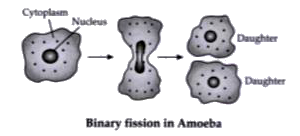Explain Binary Fission in Amoeba and Multiple fission in Plasmodium.
Video Solution
Text Solution
In the process of fission, a unicellular organism splits to form two or more new organisms. It is of two types.
(a) Binary fission: In Binary Fission, the parent organism splits to form two new organisms. For example Amoeba, Paramecium Leishmania, Bacteria etc., are reproduce by binary fission.
When the amoeba cell has reachedits maximum size of growth, then first the nucleus of amoeba lengthens and divides into two parts. After that cytoplasm of parent amoeba divides to form two smaller daughter amoebae.
In amoeba fission take place in any plane but in Leihsmania splitting of parent cell during fission takes place in definite place longitudinal with respect to flagellum at its end.

Multiple Fission: In multiple fission the parent organism splits to form many new organisms at same time. For example, Plasmodium.

During unfavorable conditions, a cyst or protective wall is formed around the cell of plasmodium. Inside the cyst the nucleus of cell splits several times to form many daughter nuclei and then cytoplasm collects around each daughter nuclei. Thin membranes are formed. So many new daughter cells are formed within a cyst. When favorable conditions arrive the cyst breaks open and daughter cells are released, each forming a new organism.
|
Updated on:21/07/2023
Topper's Solved these Questions
- BOOK - OSWAL PUBLICATIONCHAPTER - DIKSHA QUESTIONS EXERCISE - REPRODUCTION (LONG ANSWER)18videos
DIKSHA QUESTIONS
- BOOK - OSWAL PUBLICATIONCHAPTER - DIKSHA QUESTIONS EXERCISE - REPRODUCTION (MULTIPLE CHOICE QUESTIONS)9videos
DIKSHA QUESTIONS
- BOOK - OSWAL PUBLICATIONCHAPTER - DIKSHA QUESTIONS EXERCISE - REPRODUCTION (VERY SHORT ANSWER)6videos
DIKSHA QUESTIONS
- BOOK - OSWAL PUBLICATIONCHAPTER - HEREDITYEXERCISE - BOARD CORNER (Long Answer Type Questions)4videos
HEREDITY
Similar Questions
Knowledge Check
- Question 1 - Select One
Multiple fission in Plasmodium is
AGamogamyBSchizogonyCSporulationDNone of these - Question 2 - Select One
Binary Fission is :
ASexual method of reproductionBAsexual method of reproductionCBoth (A) and (B)DNone of the above. - Question 3 - Select One
Binary fission in Amoeba occurs by
AMitosisBMeiosisCAmitosisDNone of the above.

